Briolette of India/South Africa Diamond
Open FREE Unlimited Store Join Our Newsletter
Lareef A. Samad B.Sc (Hons)
Origin of Name
The name Briolette of India seems to emphasize both the unique shape of the diamond, the briolette, a form of rose-cut, known as the double rose-cut, which was a popular shape/cut for diamonds in the past, as well as the country of origin of the diamond. However, in the light of the revelation in the 1950s that the diamond was actually of South African origin, and was deliberately given a pseudo name and history to portray the diamond as a superior Golconda diamond of Indian origin, with a view of enhancing its market value, a practice usually resorted to by diamond prospectors of the time, given the unfair bias associated with the quality of South African diamonds, it is suggested that the diamond be given an appropriate name to reflect its true origins. It is in this context that we have adopted the name Briolette of India/South Africa, reflecting the true origin of the diamond South Africa, while still retaining the pseudo-name India.

Briolette of India and a smaller cushion-shaped diamond set as a pendant to a necklace and hanging from a button-shaped pearl
Characteristics of the diamond
The 4Cs of the diamond
The Briolette of India is a D-color (colorless) diamond weighing 90.38 carats and cut in the form of a briolette, also known as a double-rose cut. The clarity of the stone is unknown, but perhaps exceptional given the fact that only diamonds of exceptional quality are chosen for the briolette cut, as it reveals more of the interior of the diamond than any other cut, and hence presence of inclusions become very obvious.
The diamond is a rare Type IIa diamond
If the diamond is D-color, it must be a Type IIa diamond, which are known as the "purest of the pure" of all diamonds. Type IIa diamonds are chemically pure and structurally perfect diamonds. Thus two factors that commonly cause color in diamonds are absent in Type IIa diamonds. They are, absence of chemical impurities, such as nitrogen, boron and hydrogen, and absence of any plastic deformations in the crystal. However, Type IIa diamonds constitute only about 1-2 % of all naturally occurring diamonds.
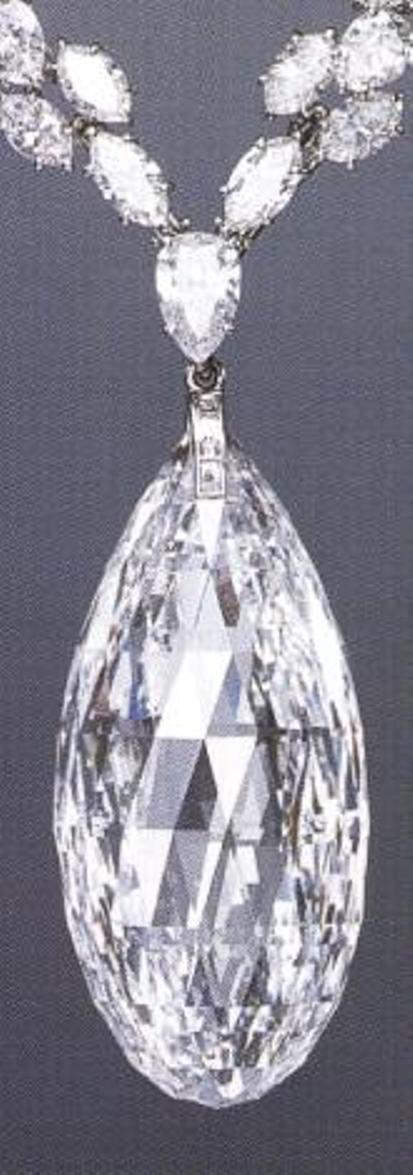
Briolette of India - entire surface covered with small triangular facets.
Pseudo-history of the diamond
The Briolette of India is perhaps the oldest diamond on record in the world if the pseudo-history given to the diamond is accepted
According to the Pseudo-history given to the diamond, the "Briolette of India" is a historical diamond, and perhaps the oldest diamond on record in the world, even older than the famous Koh-i-Noor diamond. The stone dates back to the time of the crusades between 1122 and 1200. The recorded history of the Koh-i-Noor diamond begins only after the year 1295, according to the "Baburnama" (memoirs of Babur) written by Emperor Babur himself, the first of the great Mogul Emperors of India.
The diamond was first acquired by Eleanor of Aquitaine when she was Queen of France (1137-1152) and later brought to England in 1154 when she became Queen of England
The diamond was first reported to have been acquired by Eleanor of Aquitaine, the Queen consort of King Louis VII of France, probably between 1137, the year of her father's death and marriage to Louis, the heir to the French throne, and 1152, the year King Louis VII divorced her for misconduct. Eleanor was the daughter of William X, the duke of Aquitaine, whose domain was larger than that of the French King himself. Eleanor inherited the Duchy of Aquitaine after her father's death in 1137, and in July 1137 married Louis, the heir to the French throne, who succeeded his father Louis VI, in August 1137, as King of France. Eleanor accompanied her husband Louis, on the second crusade, between 1147 to 1149, to protect the Kingdom of Jerusalem, from Turkish assault.

Effigy of Eleanor of Aquitaine in the Church of Fontevraud Abbey, Anjou, France - photo by Adam Bishop

14th-century painting of Raymond of Poitiers welcoming Louis VII in Antioch
After the annulment of their marriage in 1152, Eleanor regained back her possession of Aquitaine, and two months later married Henry Plantagenet, the Duke of Normandy, who was the grandson of Henry I of England. In 1154, Henry Plantagenet succeeded his grandfather, as King Henry II of England, and Eleanor became the Queen of England. To King Henry II, Eleanor bore five sons and three daughters.
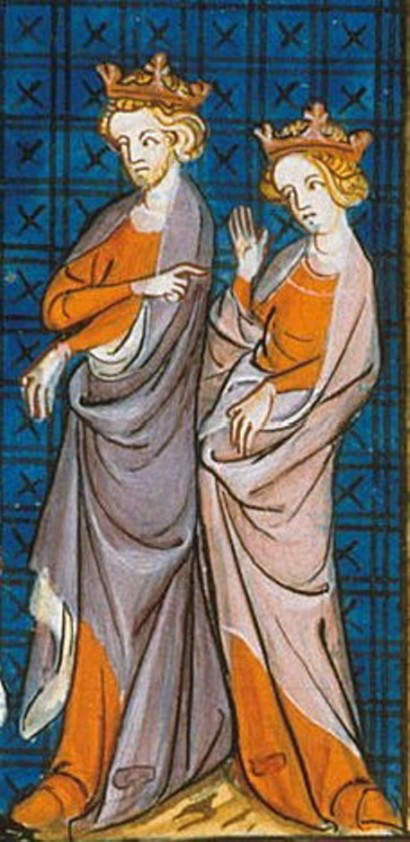
14th-century representation of Henry II and Eleanor
The Briolette of India was inherited by King Richard I of England who carried the diamond with him on the third crusade
When Henry II died in 1189, he was succeeded by his third son Richard, who later came to be known as Richard the Lion Heart. King Richard I is said to have carried with him the Briolette of India, when he took part in the third crusade that lasted from 1189 to 1192.
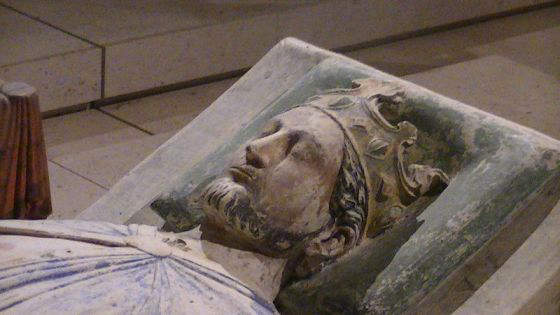
Effigy of Richard I of England in the Church of Fontevraud Abbey
The Briolette of India disappears for over three centuries after the death of King Richard the Lion Heart, and reappears again only in the late 16th-century, during the reign of King Henry II of France
After Richard I, the diamond disappeared for over three centuries, and re-appeared again only in the late 16th century, during the reign of King Henry II of France (1547-59), whose Queen consort was Catherine de Medicis. Henry had a mistress by the name of Diana de Poitiers, to whom he was closely attached. Henry presented the Briolette of India to Diana de Poitiers, and it can be seen in one of many portraits of her while at Fontainbleau, a palace of the French kings in northern France, which was previously a royal hunting lodge.

King Henry II of France - 1547 to 1559
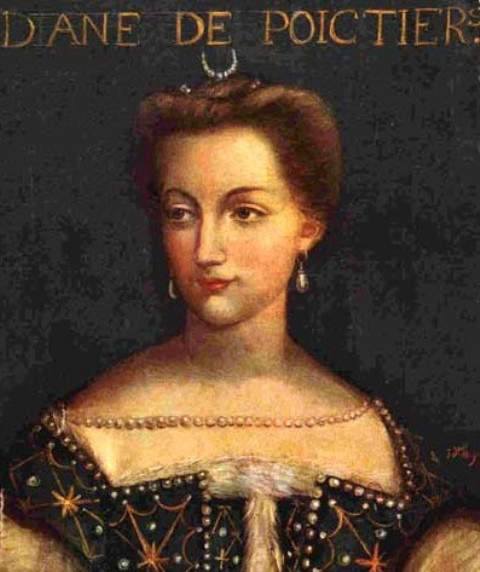
Diane de Poitiers - Mistress of King Henry II
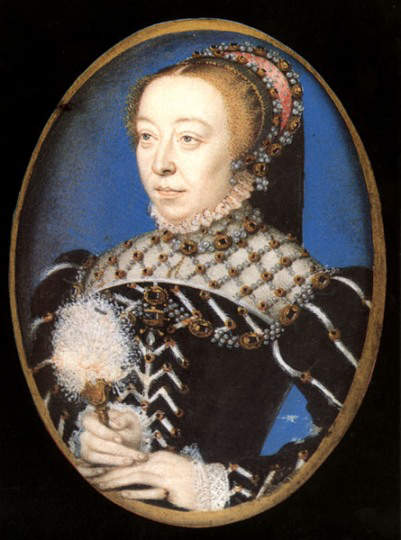
Catherine de Medici - wife and Queen Consort of King Henry II of France
After Henry IIs death in 1559, Diana de Poitiers was forced by Catherine de Medicis to surrender those crown jewels that Henry had given her, and this may have included the Briolette of India. In spite of Henry's abiding attachment to his mistress, Catherine's marriage was not unsuccessful, and she bore him 10 children, of whom 4 boys and 3 girls survived. Three of her sons eventually became kings of France - Francis II, Charles IX and Henry III.
True history of the diamond
The Briolette of India resurfaces again after four centuries and is acquired by Harry Winston.
The stone again disappeared for four centuries, and re-appeared only in 1950. This time the stone was acquired by Harry Winston, the New York jeweler, who purchased it from an Indian Maharajah. Harry Winston sold the diamond to Dorothy Killam, wife of the Canadian millionaire and philanthropist I. W. Killam, but bought it back from her estate, when she died 10 years later.

Izaak Walton Killam, Canadian financier and philanthropist, husband of Dorothy Killam
Briolette of India draws international attention again in 1967 when fashion model Penelope Tree is photographed by Richard Avedon holding the diamond in front of her right eye
In 1967, the Briolette of India again drew international attention, when it was photographed by the renowned American fashion photographer Richard Avedon, being held by fashion model Penelope Tree in front of her right eye, the diamond almost covering the entire right eye. Please click on the following link for this image :- https://denverlibrary.org/content/whos-girl
Harry Winston exhibits the diamond in 1970 at a dinner organized for American fashion editors
In the year 1970, Mr. Harry Winston exhibited the stone at the diamond dinner organized for American fashion editors. According to Christie's website the Briolette of India was bought and sold by Harry Winston three times between 1946 and 1971. It is currently believed to be in the collection of a titled European family.
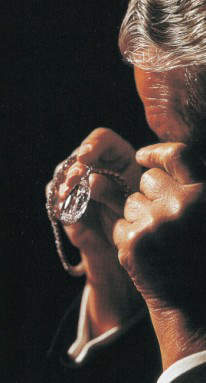
Harry Winston examining the Briolette of India Diamond
The true origin of the Briolette of India revealed after Harry Winston acquired the diamond in 1950
The true origin of the Briolette of India was revealed only after Harry Winston acquired the diamond in 1950. It was shown that the Briolette of India, was not actually an Indian diamond, but a South African diamond discovered in the late 1890s or the first decade of the 20th-century (1901-1910). The actual mine of origin is not known, but could be any one of the early deep diamond mines opened in the Kimberley region, such as the Kimberley mine (1871), De Beers mine (1870), Dutoitspan mine (1870), the Koffiefontein mine (1870), the Bultfontein mine (1874) and the Wesselton mine (1890) , or the Jagersfontein mine situated 130 km southeast of Kimberley and opened in 1888, or the Premier diamond mine situated 38 km northeast of Pretoria, and opened in 1902. However, given the high quality of the diamond (D-color or top-color) possible mines where the diamond could have originated are Premier diamond mine, Jagersfontein diamond mine or Wesselton diamond mine; mines that produced some of the notable colorless diamonds, such as the 3106-carat Cullinan diamond (Premier 1905), 995-carat Excelsior diamond (Jagersfontein 1893) and the 650-carat Reitz diamond (Jagersfontein 1895).
The rough diamond was cut into a briolette not in India but in Neuilly, Paris in 1909
The weight of the rough diamond is also not known, but Cartier of Paris had acquired the rough diamond,together with the 100.5-carat Blue Heart rough diamond discovered in the Premier diamond mines of South Africa, in November, 1908. It appears that Cartier had entrusted both rough diamonds to the renowned French diamond cutting firm, Atanik Ekyanan of Neuilly, Paris, for cutting and polishing, a task that was completed in 1909. Cartier initially set the briolette-cut, 90.38-carat diamond as a pendant to a necklace together with a 126-grain pearl, but in 1910 change the setting to a brooch, incorporating the same pearl and two 22-carat emeralds. The brooch was sent to Cartier's New York branch and sold in 1911 to the American financier George Blumenthal, who gifted it to his wife Florence. The briolette again resurfaced only in 1950, when it was purchased by Harry Winston, who later sold it to Dorothy Killam and re-purchased it from her estate after her death in 1960.

Florence Blumenthal wife of American financier and philanthropist George Blumenthal
The Briolette of India is neither a diamond of Indian origin nor was it cut in India as portrayed in the pseudo-history of the diamond given above
In the light of the above revelations, the Briolette of India diamond is neither an Indian diamond nor was it cut in India, as it was portrayed in the fanciful history created for it, by the original owner of the diamond, Pierre Cartier. Hence, the entire history of the diamond, starting with Eleanor of Aquitaine purchasing the diamond in the 12th-century, when she was Queen of France; carrying the diamond to England when her husband Henry Plantagenet ascended the throne as King Henry II of England; King Richard the Lion Heart carrying the diamond into battle during the 3rd Crusade; the diamond reappearing in France in the 16th-century during the reign of King Henry II, who gifted it to his mistress Diana de Poitiers, but later surrendered to Queen Catherine de Medicis after her husband's death; seems to have been conjured up in the fertile imagination of a seasoned story teller. The fanciful history given for the diamond was not challenged previously as the events mentioned in it concided with established historical facts.
Reasons that might have prompted the creation of pseudo-histories for diamonds of South African origin in the late 19th and early 20th centuries
Such fanciful histories are usually given to diamonds in order to enhance their provenance, that has a direct bearing on their market value. Provenance can enhance the value of a diamond several folds of its market value. Moreover, the Briolette of India diamond though a top color diamond, was of South African origin, and during the early days of the discovery and production of diamonds in South Africa, the diamonds produced, particularly the yellowish and brownish Cape series, were believed to be of inferior quality, in comparison with the high quality Golconda diamonds that originated in Southern India. Hence, many top color diamonds that originated in South Africa during this time were deliberately given an Indian provenance, in order to facilitate their owners to realize their full potential value.
Blue Heart diamond, a South African blue diamond discovered in 1908 in the Premier diamond mine, and cut by the same master cutters in Paris was also given an enhanced provenance
Pierre Cartier also seems to have given the Blue Heart diamond, another South African diamond, that was cut at the same time as the Briolette of India, by the same master cutters of Atanik Ekyanan of Neuilly in Paris, an enhanced provenance, by claiming that the diamond was once owned by Empress Eugenie, a connoisseur and collector of diamond jewelry, and the spouse of Napoleon III, the dictator of France, who ruled between 1852 to 1970. Hence, the Blue Heart diamond was sometimes mistakenly referred to as the "Eugenie diamond." The confusion created by the pseudo-history given to the Blue Heart diamond was only cleared after research carried out by a team of scientists of the Natural History Museum of the Smithsonian Institution. Please refer to our webpage on the Blue Heart diamond for more details.
The Briolette of India has earned the rare distinction of being one of the most perfectly cut briolette diamonds in the world not withstanding the pseudo-history previously given to the diamond
Despite the false history given to the Briolette of India, the 90.38-carat, briolette-cut, D-color diamond of South African origin undoubtedly remains the most famous briolette-cut diamond in the world, able to stand on its own credentials with other famous diamonds in the world, not withstanding its South African origin and Parisian cut. In fact the diamond has earned the rare distinction of being one of the most perfectly cut briolette diamonds in the world.
The resurgence of the briolette
Some famous briolette diamonds
The briolette is an 800-year old cut whose popularity has waxed and waned during this long period. Briolettes became very popular in France in the 18th and 19th centuries, and in other countries, in the late 19th and early 20th centuries, and was used in pendants, earrings, and necklaces. In America briolettes were quite popular in the 1930s. Briolettes are found in the crown jewels of many royal families, such as the Hapsburg dynasty of Austria, the Romanovs of Russia, and the royal and Napoleonic houses of France. Some of the famous briolette-cut diamonds are :-
1) Napoleon Bonaparte's diamond necklace with briolette-cut diamond fringes
The world renowned Smithsonian Gem and Mineral collection includes a 263-carat diamond briolette necklace presented by Napoleon Bonaparte in 1811 to his Empress consort Marie Louise, to celebrate the birth of their son, the future King of Rome. The necklace has 19 diamond fringes made of briolette-cut, oval and pear shaped diamonds and accented by small, round diamonds and diamond set motifs.
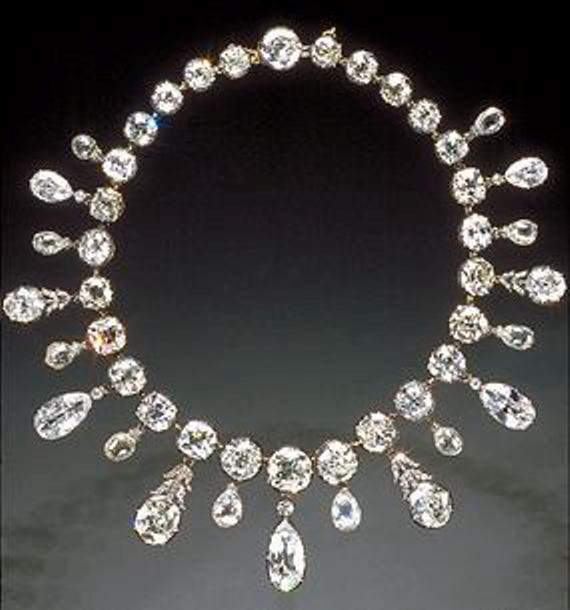
Napoleon's Diamond Necklace with briolette-cut diamond fringes at the NMNH of the Smithsonian Institution
© Smithsonian Institution
2) The 95-carat, briolette-cut, yellow diamond known as the Walska Diamond set in a swan motif pendant clip incorporating white diamonds and green emeralds, and the briolette diamond hanging as a pendant from the beak of the swan
Another famous briolette-cut diamond is the 95-carat, briolette-cut, yellow diamond of South African origin, set in a diamond pendant clip by Van Cleef & Arpels in 1971, that once belonged to the renowned Polish-born Soprano of the earrly 20th-century Madame Ganna Walska (1887-1984), who died at the ripe old age of 97 years.
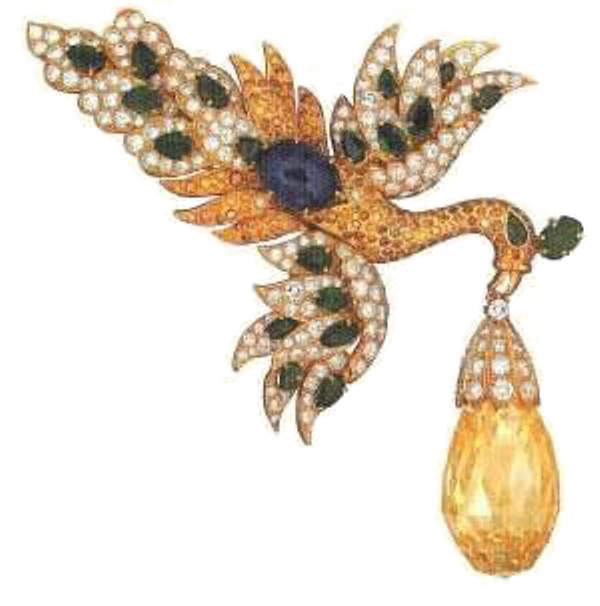
Diamond Pendant Clip from Ganna Walska's Jewelry Collection
3) 100.60-carat, fancy orange-brown, briolette-cut diamond sold at Christie's Magnificent Jewels Sale in Geneva in May 2007
The 100.60-carat, fancy orange-brown, briolette-cut diamond was sold for $1 million at a Christie's Magnificient Jewels Sale held in Geneva on May 16, 2007. The diamond was set in a pave-set diamond surround with a pavé-set diamond hook-and-eye clasp through which a cord or chain can be passed to suspend the diamond as a pendant. This diamond is the 6th largest briolette-cut diamond in the world.
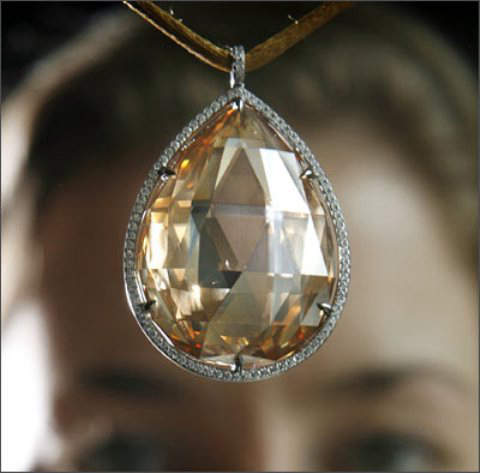
100.60-carat fancy orange-brown briolette-cut diamond that sold at Christie's Magnificient Jewels Sale in Geneva on May 16, 2007
4) A 19.13-carat fancy grayish-yellowish-green chamaleon briolette-cut diamond
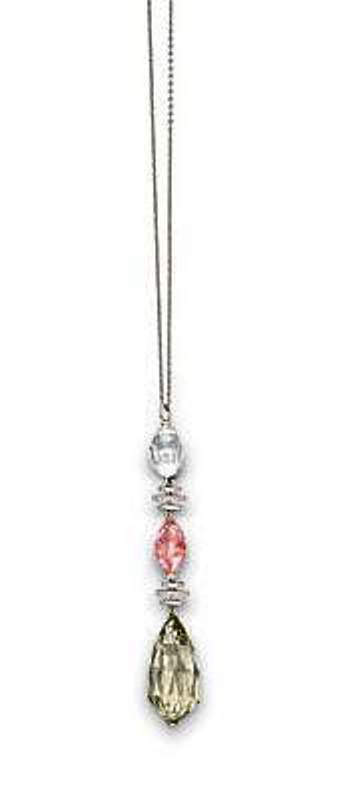
Fancy greyish-yellowish-green chamaleon briolette-cut diamond pendant necklace
The 19.13-carat, fancy grayish-yellowish-green, chamaleon, briolette-cut diamond was incorported as a pendant to a necklace, that also included a smaller marquise-cut pink diamond and a drop-shaped white diamond. The Chamaleon diamond reacts to gentle heat or dark storage by temporarily changing color from grayish-green to yellow. According to Chrisrie's this diamond is the largest briolette-cut chamaleon diamond in the world to be offered at an auction. The pendant necklace sold for US$ 987,000 to an European dealer.
5) Graff Pearl and Diamond Necklace with a pendant whose centerpiece is a pink briolette-cut diamond
The Graff Pearl and Diamond Necklace consists of a single strand of 29 pink hued cultured pearls. The shape of the pearls are spherical or near-spherical. A diamond-set pendant hangs as the centerpiece of this necklace.

The Graff Pearl and Diamond Necklace
The overall shape of this pendant is a perfect pear-shape, and consists of a single marquise-cut diamond and two pear-cut diamonds at the base of the pendant, and two rows of round brilliant-cut diamonds on the body of the pendant. The outer row has 15 diamonds and the inner row 13 diamonds. The center of the diamond is occupied by a briolette-cut pink diamond, whose pink color matches the pink color of the pearls. The total weight of all the diamonds in the pendant is 30.62 carats.

Close-up view of the pendant of Graff Pearl and Diamond Necklace. The centerpiece of this pendant is a pink briolette-cut diamond
6) 3.6-carat natural color brown briolette-cut diamond

3.6-carat brown briolette-cut diamond
7) A perfectly cut white briolette-cut diamond of unknown weight
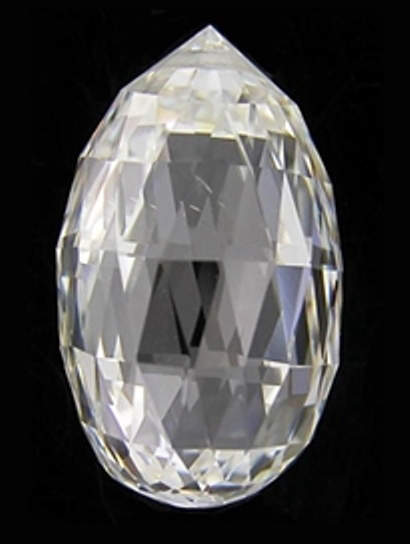
Perfectly cut white briolette-cut diamond
8) The Vainer Briolette Diamond

The 116.60-carat Vainer Briolette Diamond
The Vainer Briolette diamond is the second largest briolette-cut diamond in the world, after the 180.85-carat, unnamed, yellow, briolette-shaped diamond belonging to an anonymous owner, which is the largest briolette-cut diamond in the world. It is a fancy light yellow color South African diamond, with an unknown clarity grade, having 192 triangular facets and a perfect polish and symmetry. The third largest briolette-cut diamond, also unnamed, weighs 114.64 carats. The 4th largest briolette-cut diamond is a 107.43-carat, fancy yellow diamond sold at a Sotheby's auction on May 16, 2002. Another 101.25-carat fancy yellow briolette-cut diamond also owned by Messrs. Vainer Ltd. of London is the 5th-largest briolette-cut diamond in the world.
9) 107.43-carat fancy yellow briolette-cut diamond sold at Sotheby's Geneva Sale May 16, 2002

107.43-carat fancy yellow briolette-cut diamond
© Sotheby's
The 107.43-carat, fancy yellow, briolette-cut diamond, sold at the Sotheby's Magnificent Jewels Sale in Geneva on May 16, 2002, is the 4th largest briolette-cut diamond in the world.
10) 75.51-carat briolette-cut diamond cut by master cutters of William Goldberg Diamond Corporation
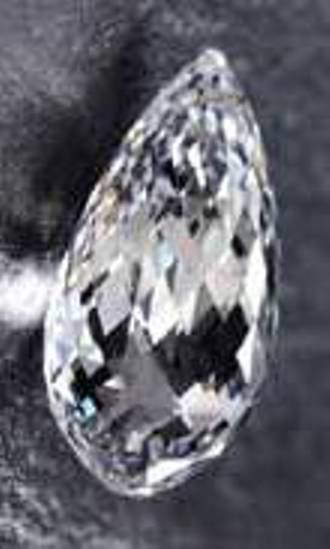
75.51-carat D-color internally flawless briolette-cut diamond
Cut by the master-cutters of William Goldberg Diamond Corporation of New York from a 160.5-carat rough diamond, the 75.51-carat unnamed briolette is a rare and unique diamond in this category with many outstanding characteristics, such as a well-proportioned cut, purity of color and high degree of transparency possessed only by the rare Type IIa diamonds, and referred to by idiomatic expressions such as "whiter than white," "purest of the pure," and "diamonds of the purest water" etc. The diamond is certified both by the GIA and GGL as D-color and internally flawless.
The GIA report was accompanied by the following note :- "According to the records of the GIA Gem Trade Laboratory, the 75.51 carat diamond described in the GIA Diamond Grading Report no 11812033, is the largest Briolette Shaped, Flawless or Internally Flawless, D Colour, diamond that we have graded as of the date of this letter and the report issued (January 7, 2002)."
The GGL report dated March 8, 2002, was accompanied by an appendix, which confirms the GIA report :-This extraordinary diamond is the largest D colour, internally flawless diamond fashioned in the briolette style, which the Gubelin Gem Lab has examined to date.
Please open the following link for a clear photograph of the 75.51-carat briolette-cut diamond :- https://www.williamgoldberg.com/about/famous_stones/briolette/
GIA definition of a briolette-cut gemstone
The term briolette is derived from the French word "brio", meaning spirit or vivacity, a quality amply possessed by this historic cut. Briolette and pendeloque are shapes given to diamonds and other gemstones by employing the drop-cut, which is a method of faceting gemstones into a pear-shape, suitable for pendants, earrings, and other jewelry. A pendeloque is a pear-shaped modification of the round brilliant-cut used for diamonds. A briolette is an elongated pear-shaped stone, covered with bands of triangular or rectangular facets, usually with a pointed end, and round at the other end, and without a girdle. The Gemological Institute of America defines the briolette as a pear or drop-shaped gemstone having it's entire surface covered with small triangular facets. The briolette is considered as a modified double-rose cut, with a pointed tip and a rounded bottom, and several rows of facets in between.
Comparison of the briolette-cut with conventional round brilliant-cut diamonds
The unique feature of the briolette is, that the beauty of the stone can be appreciated from all sides, at any angle, and not restricted to a table as in the conventional diamond, cut with a table, crown and pavilion. The conventional diamond is expected to be viewed only through the table, and the brilliance of the stone depends on the amount of incident light returning to the eye after entering the diamond. If the pavilion of the diamond has a angle close to 90 ° at the vertex (culet), the diamond is said to be well cut, as all light entering the diamond through the table will be totally and internally reflected twice at the inner surface of the pavilion, and will leave the diamond again through the table. If the angle of the pavilion, at the vertex is an obtuse angle, greater than 90°, the diamond is said to have a shallow cut pavilion, and some light will be refracted through the pavilion, reducing the brilliance. Likewise if the angle at the vertex is an acute angle, less than 90°, the diamond is said to have a deep cut pavilion, which also results in the loss of light by refraction through the pavilion, and a consequent loss of brilliance. In the case of the briolette, light can enter through the triangular or rectangular facets from any side of the diamond, and most of this light is refracted and emerges through the opposite side. If at all there will be a return of light rays after entering the stone, through the same facet, it will only be very slight. Thus the briolette cannot have the same brilliance as a conventional cut stone.
Why briolettes are more suitable for pendants and drop-earrings ?
Briolettes are more suitable for pendants and earrings, because they dangle and catch the light. The stone is totally free of any setting except at the top, allowing one to see more of the gem than with other cuts. Therefore stones with defects and inclusions may not be suitable for briolettes.
Resurgence of the briolette-cut after the Victorian era
The briolette that saw a resurgence during the Victorian age but later died down, is again having a dramatic revival in the gem industry, not so much for diamonds but for precious and semi-precious stones. Briolette pendants and earrings made of gemstones like tourmalines, sapphires, amethysts, aquamarines, etc. are becoming increasing popular, and a cheaper version of the costly ultrasonic drill has been developed to make accurate holes of small diameter at the pointed end of the briolette. Virtually any gemstone material can be used for briolettes.
You are welcome to discuss this post/related topics with Dr Shihaan and other experts from around the world in our FORUMS (forums.internetstones.com)
Related :-
3) Doris Duke's Ganna Walska Indian Arya Necklace
References :-
1) Diamonds - Famous, Notable and Unique- GIA 1974
2) Briolette of India - encyc.org/wiki/briolette-of-india
3) Diane de Poitiers - From Wikipedia, the free encyclopedia
4) Blue Heart Diamond -www.internetstones.com
5) The Dynamic Earth - GeoGallery - Napoleon Diamond Necklace - www.mnh.si.edu/earth/text/geogallery
6) Christie's New York Jewels Sale - April 22, 2009 - Press Release - Christie's April Jewel Sale Features Exquisite Gems from Ear Clips to an Elephant.
7) A Highly Important Colored Diamond Pendant - Christie's Geneva Sale 1347. May16, 2007 - Lot 234
Powered by Ultra Secure
Amazon (USA) Cloud Network

Founder Internet Stones.COM
Register in our Forums
| Featured In
|
|
|
|
|
|
|
|


















